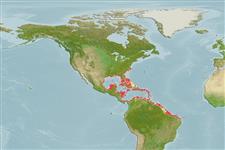>
Gobiiformes (Gobies) >
Eleotridae (Bully sleepers)
Etymology: Dormitator: Latin, dormire = to sleep (Ref. 45335); maculatus: Specific name means 'spotted' or 'stained'.
More on author: Bloch.
Environment: milieu / climate zone / depth range / distribution range
Ecologia
marinhas; Água doce; estuarina demersal; anfídromo (Ref. 51243). Tropical; 17°C - 35°C (Ref. 35237); 37°N - 5°S
North to South America: along the Atlantic slope from North Carolina (USA) to southeastern Brazil.
Tamanho / Peso / Idade
Maturity: Lm ? range ? - ? cm
Max length : 70.0 cm TL macho/indeterminado; (Ref. 26340); common length : 14.5 cm TL macho/indeterminado; (Ref. 12193)
Descrição suscinta
Chaves de identificação | Morfologia | Morfometria
Espinhos dorsais (total) : 1 - 7; Raios dorsais (total) : 9 - 15; Espinhos anais: 0 - 1; Raios anais : 9 - 10. A short stubby fish with a conspicuously flat head (Ref. 26938).
Facultative air-breathing in the genus (Ref. 126274); Adults inhabit marshes, muddy ponds and channels with a salinity range of 0 to 21 ppt (Ref. 7251), up to 38.4 ppt in some cases (Ref. 97140). Mostly found in fresh water but also in brackish mangrove areas. They ascend upstream but remain in the lower reaches. Sexually mature after one year. Gonads develop during the dry season. Average size at maturity is 5.1 cm for males, 4.5 cm for females. Omnivorous, adults feed mainly on plants, sediments and invertebrates. They undergo coloration change during reproduction, carrying out a complex nuptial parade. Adults guard the nest. Egg is 0.3 mm, incubation time is 11 to 16 hours at 27°C (Ref. 35237).
Ciclo de vida ou comportamento de acasalamento
Maturidade | Reprodução | Desova | Ovos | Fecundidade | Larvas
Robins, C.R. and G.C. Ray, 1986. A field guide to Atlantic coast fishes of North America. Houghton Mifflin Company, Boston, U.S.A. 354 p. (Ref. 7251)
Status na Lista Vermelha da UICN (Ref. 130435: Version 2024-1)
Ameaça para os humanos
Harmless
Uso pelos humanos
Pescarias: espécies comerciais; Aquário: Espécies comerciais
Ferramentas
Relatórios especiais
Baixar XML
Fontes da internet
Estimates based on models
Preferred temperature (Ref.
123201): 23.5 - 28.1, mean 27.3 °C (based on 807 cells).
Índice de diversidade filogenética (Ref.
82804): PD
50 = 0.5312 [Uniqueness, from 0.5 = low to 2.0 = high].
Bayesian length-weight: a=0.01000 (0.00420 - 0.02379), b=3.08 (2.88 - 3.28), in cm total length, based on LWR estimates for this (Sub)family-body shape (Ref.
93245).
Nível Trófico (Ref.
69278): 2.5 ±0.1 se; based on diet studies.
Resiliência (Ref.
120179): Muito baixo(a), tempo mínimo de duplicação da população maior que 14 anos (Preliminary K or Fecundity.).
Fishing Vulnerability (Ref.
59153): Moderate to high vulnerability (48 of 100).
Nutrients (Ref.
124155): Calcium = 90.6 [51.5, 209.0] mg/100g; Iron = 0.891 [0.443, 1.695] mg/100g; Protein = 18 [16, 20] %; Omega3 = 0.167 [0.096, 0.275] g/100g; Selenium = 44.5 [22.5, 96.4] μg/100g; VitaminA = 14.7 [4.5, 40.1] μg/100g; Zinc = 1.63 [1.14, 2.44] mg/100g (wet weight);
